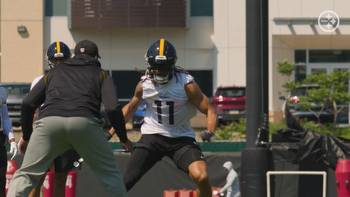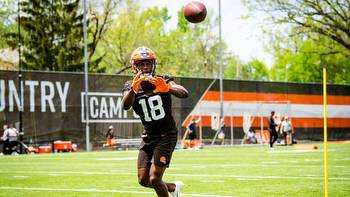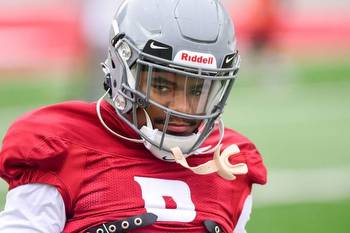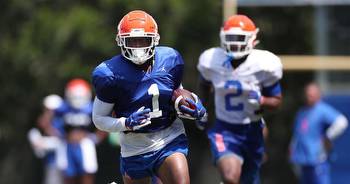Farabaugh: Chase Claypool Should be Steelers Slot Wide Receiver

Chase Claypool did not have the 2021 season he envisioned. With controversy surrounding his entire season, Claypool’s stock fell after an encouraging rookie season with the Steelers. In many ways, Claypool was simply the same player. His stats were nearly identical and so was the product on film.
Claypool primarily aligned up as a Z-receiver, which puts him on the outside and off the line of scrimmage. It led to Claypool getting a lot of forced balls down the sideline on go balls. Still, Claypool was inconsistent in winning those balls at a high level. Where do the Steelers go from here with Claypool at this point? There is an obvious solution to that problem, and that is to move Claypool to the slot.
Chase Claypool Struggled Outside
First, why is Chase Claypool not flourishing outside? After all, this is a 6-foot-4 receiver who runs a 4.42. If anything, Claypool should be a player that wins deep and outside because of a rare size and speed combination. It worked for someone like DK Metcalf. That was the comparison for Claypool when he was looking to take his year two leap. His leap never came for a few reasons.
For one, Claypool struggles to stack defensive backs once he gets behind them. The size and speed combination often allows him to win deep, there is no doubt about that. Stacking a defensive back means once a receiver wins at the line of scrimmage, they have to win to get back on top of that defensive back. That often entails beating down the defensive back’s hands and getting their near shoulder out of the way. If the defensive back is still able to maintain contact and control the receiver, they are able to mirror that receiver and be in a spot for a pass breakup downfield.
That is Claypool’s problem. He can win off the line, but he fails to get on the top of that cornerback, which allows them to recover and work back into Claypool’s frame. PlayerProfiler’s stats paint the picture of Claypool’s circumstances well. Claypool’s 50% contested catch rate is pretty good. That was 19th in the NFL and it was on 34 targets, which is no small sample size. The issue is that Claypool makes things a lot harder for himself when cornerbacks can make those balls contested catches when they should not be.
In addition, Claypool’s inability to handle press coverage is another issue. Claypool’s win rate against man coverage is only 29.9%, ranking 79th in the NFL according to PlayerProfiler. Meanwhile, Claypool won 39.4% against zone coverage. That is a stark difference. He separated 0.88 yards per target against man coverage versus 2.14 yards per target against zone coverage. Players are naturally likelier going to separate more versus zone than man, but that is a steep difference.
Those two traits hurt Claypool’s deep ball potential on the outside. That is not to say he should not play there anymore, but that his time on the outside left a lot to be desired given his natural skillset.
Why Claypool to the Slot
A lot of those stats listed above showcase just why Claypool may work in the slot. But there is more that goes beyond that. For one, Chase Claypool’s natural size mismatch against safeties and slot cornerbacks is obvious. If he gets on a linebacker, it is over. Still, Claypool will not have to worry as much about stacking cornerbacks from a condensed alignment. That will make it easier for him to win with his speed.
There are not many 6-foot-4 guys that run a 4.42 and primarily align in the slot. The guys that are the best at that may not even be wide receivers. Darren Waller, for example, is someone that profiles similarly to Claypool athletically. In no way does a move to the slot immediately make Claypool akin to Waller, but there is a blueprint to making Claypool’s strengths showcase themselves.
He is tough and physical. Those are two traits that Chase Claypool does carry. He can make those contested catches that are tough and must be made over the middle of the field. His natural speed will make him hard to cover all the time in that area of the field. Claypool is likely to still see man coverage, but will be able to work off the line of scrimmage away from press coverage and more often find himself trying to find the open spots in zone coverage.
The most underrated part of it all is Claypool’s ability to block. Coming out of Notre Dame, Claypool was one of the best blockers in the NCAA. When he puts his mind to it, Claypool is still a great blocker. With Matt Canada’s love of using condensed sets and stacked alignments, Claypool in the slot could be great for the team’s rushing success, too. He will be able to fit up safeties and open up lanes.
There are a lot of bigger slot receivers that do this well. The two most obvious players that do this are Chris Godwin and Cooper Kupp. Even some other guys that are a bit further down the chain like Josh Palmer do this really well. Having a slot receiver who is big and can block adds dimensions to a team’s rushing scheme and success.
Claypool’s best spot is in the slot. He does not always have to be there. The Steelers love themselves some versatile receivers and other players like Calvin Austin and George Pickens will work their way into the slot as well. Still, Claypool’s skillset and strengths are maximized in the slot. If done right, it could completely revive Claypool’s stock long-term.







































